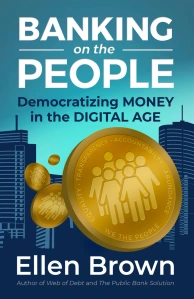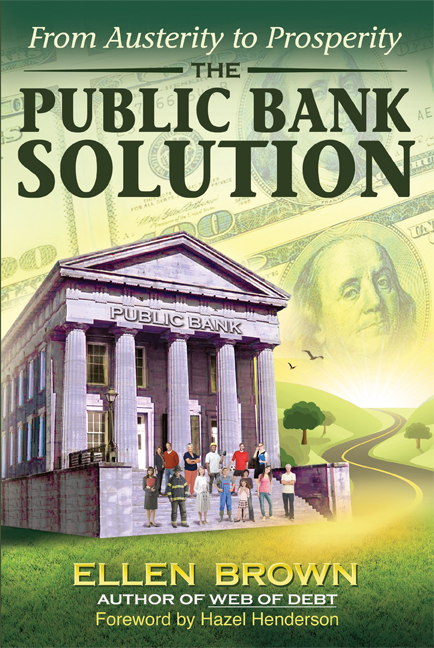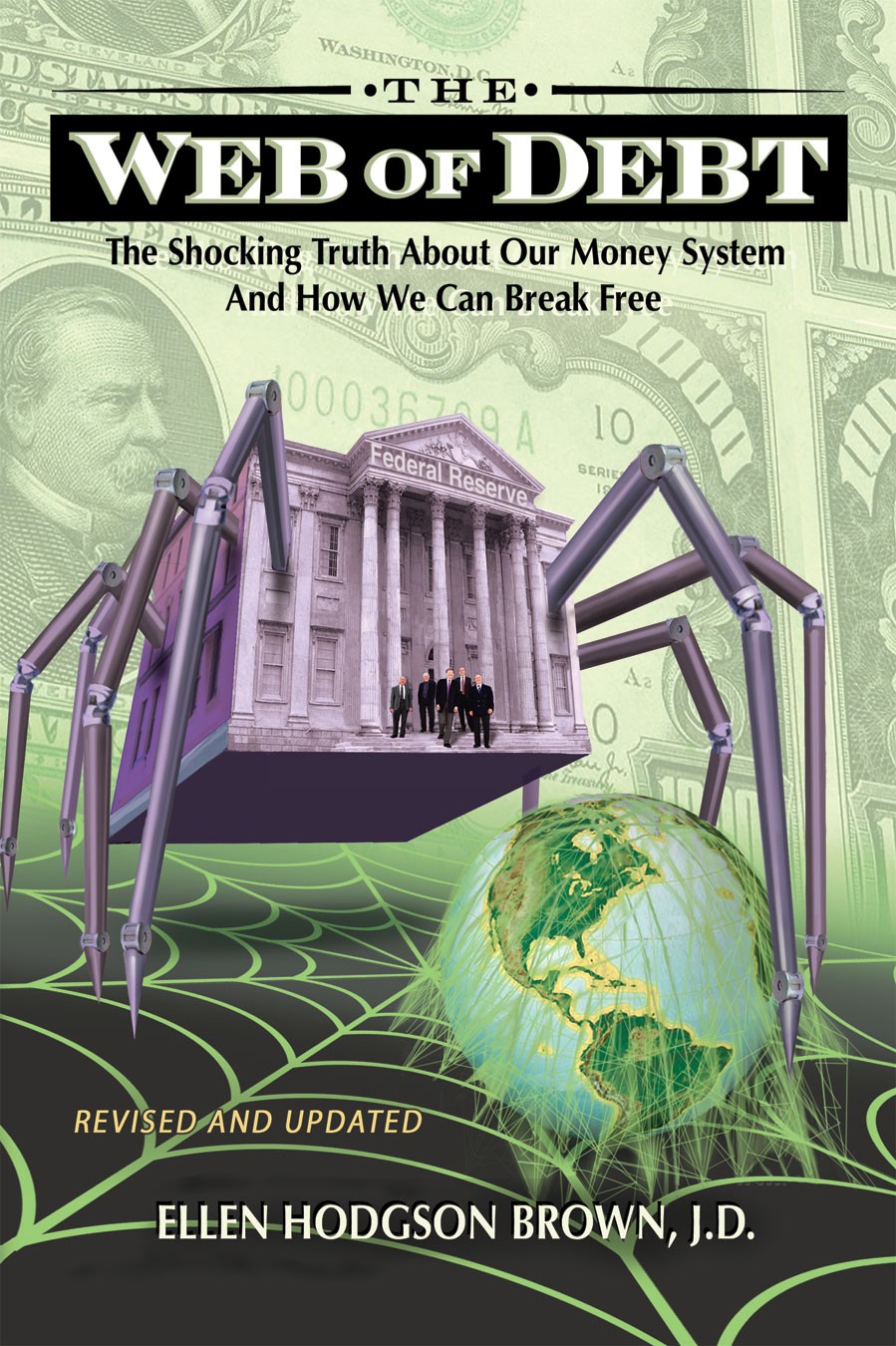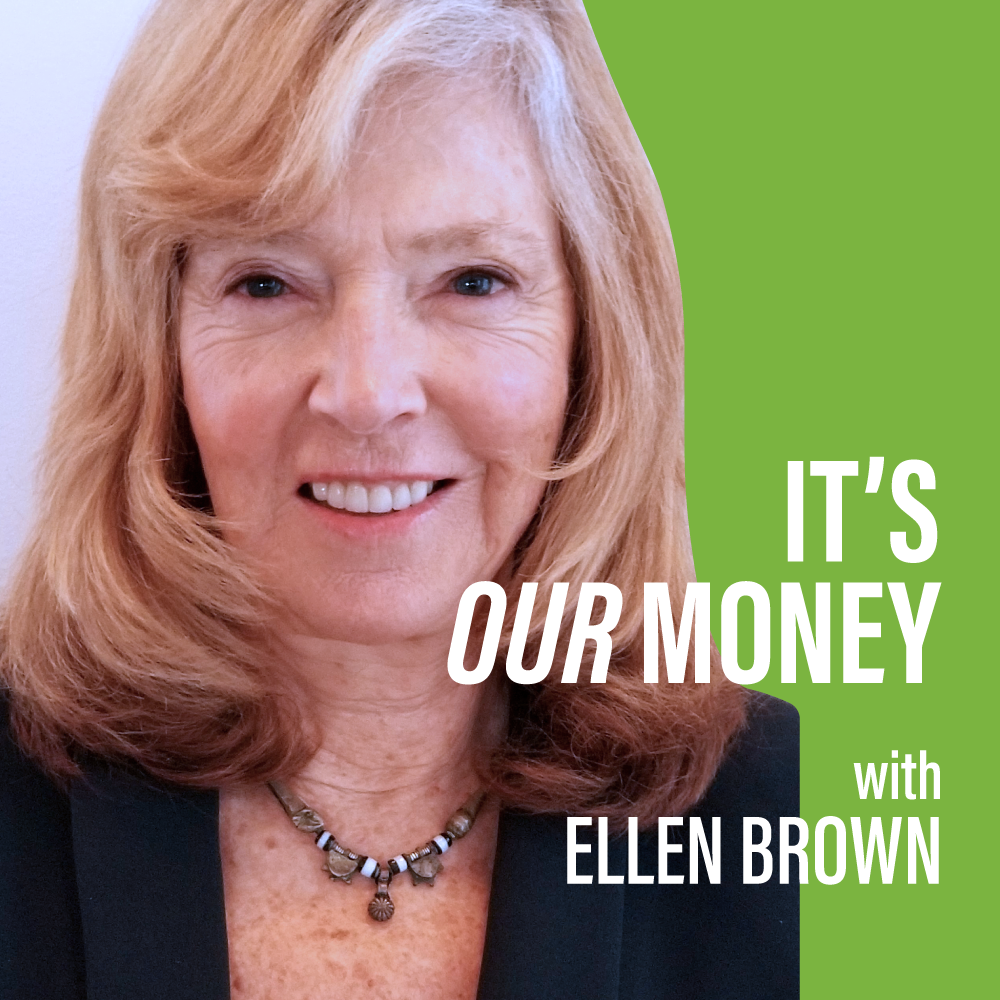Once the black sheep of high finance, government owned banks can reassure depositors about the safety of their savings and can help maintain a focus on productive investment in a world in which effective financial regulation remains more of an aspiration than a reality.
— Centre for Economic Policy Research, VoxEU.org (January 2010)
Public sector banking is a concept that is relatively unknown in the United States. Only one state—North Dakota—owns its own bank. North Dakota is also the only state to escape the credit crisis of 2008, sporting a budget surplus every year since; but skeptics write this off to coincidence or other factors. The common perception is that government bureaucrats are bad businessmen. To determine whether government-owned banks are assets or liabilities, then, we need to look farther afield.
When we remove our myopic U.S. blinders, it turns out that globally, not only are publicly-owned banks quite common but that countries with strong public banking sectors generally have strong, stable economies. According to an Inter-American Development Bank paper presented in 2005, the percentage of state ownership in the banking industry globally by the mid-nineties was over 40 percent.[i] The BRIC countries—Brazil, Russia, India, and China—contain nearly three billion of the world’s seven billion people, or 40% of the global population. The BRICs all make heavy use of public sector banks, which compose about 75% of the banks in India, 69% or more in China, 45% in Brazil, and 60% in Russia.
The BRICs have been the main locus of world economic growth in the last decade. China Daily reports, “Between 2000 and 2010, BRIC’s GDP grew by an incredible 92.7 percent, compared to a global GDP growth of just 32 percent, with industrialized economies having a very modest 15.5 percent.”
All the leading banks in the BRIC half of the globe are state-owned. In fact the largest banks globally are state-owned, including:
- The two largest banks by market capitalization (ICBC and China Construction Bank)
- The largest bank by deposits (Japan Post Bank)
- The largest bank by assets (Royal Bank of Scotland, now nationalized)
- The world’s largest development bank (BNDES in Brazil).
A May 2010 article in The Economist noted that the strong and stable publicly-owned banks of India, China and Brazil helped those countries weather the banking crisis afflicting most of the rest of the world in the last few years. According to Professor Kurt von Mettenheim of the Sao Paulo Business School of Brazil:
Government banks provided counter cyclical credit and policy options to counter the effects of the recent financial crisis, while realizing competitive advantage over private and foreign banks. Greater client confidence and official deposits reinforced liability base and lending capacity. The credit policies of BRIC government banks help explain why these countries experienced shorter and milder economic downturns during 2007-2008.
Surprising Findings
In a 2010 research paper summarized on VoxEU.org, economists Svetlana Andrianova, et al., wrote that the post-2008 nationalization of a number of very large banks, including the Royal Bank of Scotland, “offers an opportune moment to reduce the political power of bankers and to carry out much needed financial reforms.” But “there are concerns that governments may be unable to run nationalised banks efficiently.”
Not to worry, say the authors:
Follow-on research we have carried out (Andrianova et al, 2009) . . . shows that government ownership of banks has, if anything, been robustly associated with higher long run growth rates.
Using data from a large number of countries for 1995-2007, we find that, other things equal, countries with high degrees of government ownership of banking have grown faster than countries with little government ownership of banks. We show that this finding is robust to a battery of econometric tests.
Expanding on this theme in their research paper, the authors write:
While many countries in continental Europe, including Germany and France, have had a fair amount of experience with government-owned banks, the UK and the USA have found themselves in unfamiliar territory. It is therefore perhaps not surprising that there is deeply ingrained hostility in these countries towards the notion that governments can run banks effectively. . . . Hostility towards government-owned banks reflects the hypothesis . . . that these banks are established by politicians who use them to shore up their power by instructing them to lend to political supporters and government-owned enterprises. In return, politicians receive votes and other favours. This hypothesis also postulates that politically motivated banks make bad lending decisions, resulting in non-performing loans, financial fragility and slower growth.
But that is not what the data of these researchers showed:
[W]e have found that . . . countries with government-owned banks have, on average, grown faster than countries with no or little government ownership of banks. . . . This is, of course, a surprising result, especially in light of the widespread belief—typically supported by anecdotal evidence—that ‘… bureaucrats are generally bad bankers’ . . . .
What accounts for their surprising findings? The authors provide a novel explanation:
We suggest that politicians may actually prefer banks not to be in the public sector. . . . Conditions of weak corporate governance in banks provide fertile ground for quick enrichment for both bankers and politicians – at the expense ultimately of the taxpayer. In such circumstances politicians can offer bankers a system of weak regulation in exchange for party political contributions, positions on the boards of banks or lucrative consultancies. Activities that are more likely to provide both sides with quick returns are the more speculative ones, especially if they are sufficiently opaque as not to be well understood by the shareholders such as complex derivatives trading.
Government owned banks, on the other hand, have less freedom to engage in speculative strategies that result in quick enrichment for bank insiders and politicians. Moreover, politicians tend to be held accountable for wrongdoings or bad management in the public sector but are typically only indirectly blamed, if at all, for the misdemeanours of private banks. It is the shareholders who are expected to prevent these but lack of transparency and weak governance stops them from doing so in practice. On the other hand, when it comes to banks that are in the public sector, democratic accountability of politicians is more likely to discourage them from engaging in speculation. In such banks, top managers are more likely to be compelled to focus on the more mundane job of financing real businesses and economic growth.
The BRICs as a Global Power
Focusing on the financing of real businesses and economic growth seems to be the secret of the BRICs, which are leading the world in economic development today. But the BRIC phenomenon is more than just a growth trend identified by an economist. It is now an international organization, an alliance of countries representing the common interests and goals of its members. The first BRIC meeting, held in 2008, was called a triumph for former Russian President Vladimir Putin’s policy of promoting multilateral arrangements that would challenge the United States’ concept of a unipolar world.
The BRIC countries had their first official summit and became a formal organization in Yekaterinburg, Russia, in 2009. They met in Brazil in 2010 and in China in 2011, and they will meet in India in 2012. In 2010, at China’s invitation, South Africa joined the group, making it “BRICS” and adding a strategic presence on the African continent.
The BRICS seek more voice in the United Nations, the IMF, and the World Bank. They are even discussing their own multicultural bank to fund projects within their own nations, in direct competition with the IMF. They oppose the dollar as global reserve currency. After the Yekaterinburg summit, they called for a new global reserve currency, one that was diversified, stable and predictable; and they have the clout to get it. According to Liam Halligan, writing in The U.K. Telegraph:
The BRICs account for . . . around three-quarters of total currency reserves. They have few serious fiscal issues and all are net external creditors.
Western financial interests have long fought to maintain the dollar as global reserve currency, but they are losing that battle, despite economic and military coercion. Russia, China and India are now nuclear powers. The BRICS will have to be negotiated with, and the first step to forming a working relationship is to understand how their economies work. Rather than declaring war on their more successful practices, we may decide to assimilate some of them into our own.
Written for the Public Banking in America Conference April 27-28th in Philadelphia. Ellen Brown is an attorney and president of the Public Banking Institute, http://PublicBankingInstitute.org. In Web of Debt, her latest of eleven books, she shows how a private cartel has usurped the power to create money from the people themselves, and how we the people can get it back. Her websites are http://WebofDebt.com and http://EllenBrown.com.
Filed under: Ellen Brown Articles/Commentary |






[…] their more successful practices, we may decide to assimilate some of them into our own.Ellen Brown Web of Debt Written for the Public Banking in America Conference April 27-28th in Philadelphia. Ellen Brown […]
So dark the con of the moneymasters.
I think you are absolutely right in saying that politicians prefer banks NOT to be in the public sector. This is exactly what the greedy part of the 1% want – weak or no regulation, so they can take the taxpayers’ money and invest overseas, and indulge in gambling and speculation so they can make quick and huge profits at our expense. What an incredibly counterproductive and losing strategy for the 99%, yet so magnificent for the 1%. It is so hard to understand why we have allowed it to go on for so long.
It MUST be that huge sums of money are spent on making us think that government-owned banks would never work.
Why wouldn’t they work? Because the monied interests or moneymasters have brainwashed us with the idea that government-owned banks “are established by politicians who use them to shore up their power by instructing them to lend to political supporters and government-owned enterprises. In return, politicians receive votes and other favours…and that politically motivated banks make bad lending decisions, resulting in non-performing loans, financial fragility and slower growth.” Ad Nauseum.
This propaganda is so ironic, because this is exactly what the behemoth banks have been doing – spending huge amounts of money through lobbyists to curry favor with politicians, so that they will vote for less regulation on the private, for-profit banks, thereby enabling their addiction to gambling and speculation with our money, which in turn results in “non-performing loans, financial fragility and slower growth” for us, the consumer, and with little to no risk for the banks. We can all recall how one large bank transferred billions of dollars of unsecured debt and co-mingled it with FDIC-insured funds, thereby transferring the loss to the tax payer.
In addition, unrestrained speculation on the part of big banks and their ensuing losses has dried up the available money supply and this in turn appears to have caused the rise in fuel and food prices throughout the world.
So the right-wing moneymasters have come up with their huge mindfrack, alleging that government or publicly-owned banks would do the very same things – THAT THEY THEMSELVES ARE DOING AT THIS VERY MOMENT- while we, the 99% are paying for it because we have been blinded by their cunning web of lies. Now, they are even trying to get us to believe that drilling more oil wells will drive our gas prices down, while in reality, large oil conglomerates are hoarding the oil in tankers and in other various locations around the world in order to further drive up the prices.
So dark and deep the con of the moneymasters.
Interesting…but am I missing something, for surely the importance of having a government owned or controlled central bank rather than a privately owned central bank like the Fed in the USA or a weak, privately controlled central bank such as in Canada is that a private central will soon run the country into the ground, whereas a government owned central bank will not. For example, after losing control of its central bank in Canada in the early 1970’s and in the USA in 1913 with the creation of the FED both countries have seen their countries plunge into an immediate, hopeless debt. The same thing happened to England in the 1700’s and the eventual loss of its colonies, its commonwealth, and its world power.
The seed money for a public bank system can be found by separating the nation’s Trust Funds from the General Fund and cashing in the $4.6 trillion IOUs owed the funds. This initiative is explained on my website http://www.solonsays.com.
Nice website solon. I just can’t believe that people actually believe that Ron Paul is any different than these malthusian establishment politicians that always blame the poor for the national debt. His Restore America domestic plan cuts 65% food assistance and 37% medicaid (ect..) under the pretext that this is the problem. Thanks for crunching the numbers to prove that all this talk of cutting the entitlements is just a smokescreen for the real problem, usurous private banking and their kleptocrath servants in govt.
PUBLIC CENTAL BANKS THAT DONT RAPE THE PUBLIC ARE COMMUNIST
Reblogged this on Who's Making You?.
[…] Full Article: Public Sector Banks: From Black Sheep to Global Leaders « WEB OF DEBT BLOG. […]
The Bank of North Dakota is a trusted institution that has helped our state in bad times and good. I know, I live in North Dakota and would never vote to privatize our bank..
It is true that politicians don’t favour having public central banks as they depend on their friends who run the private banks and their clients for money to fund their election campaigns among other things.
Many people enter politics precisely because they have an agenda to reduce government participation and regulation in areas of the economy that are important to its proper functioning eg electricity, transport, education, health, welfare, water and energy supplies, all of which if privatised would deliver enormous and ongoing profits to their owners who would reward politicians handsomely.
The single most common response against public banking i hear from people that are at least awake to the problem of private central banking is that politicians will just use the public treasury to do the same sorts of fraud that occurs today. I’ve always maintained that due to transparency and accountability this would be more difficult; and at the very least, the fraud would be spent on the U.S. economy and not stored in some City of London vault. This arguement alone never seemed persuasive enough.
However, if it can be shown that the politicians and financial oiligarchs actually prefer private banks, even if the fed is eliminated and commodity currency established, because they can exercise more control via surreptious manipulation of laws and regulations, then i believe some headway can be made to convincing the skeptics.
This Ellen Brown has done through the data of the latest researchers and examples of current viable national banks in the BRIC countries. She has given us all another valuble weapon in our arsenal to combat global banking tyranny.
Still20112.com
[…] Fonte: Public Sector Banks: From Black Sheep to Global Leaders […]
[…] **********************************************Fonte: Public Sector Banks: From Black Sheep to Global Leaders […]
[…] on March 8, 2012 by Ellen Brown on Web of Debt Once the black sheep of high finance, government owned banks can reassure depositors about the […]
[…] Wall Street website seems to be temporarily down. This piece is cross-posted on Ellen’s Web of Debt […]
[…] Posted on March 8, 2012 by Ellen Brown on Web of Debt […]